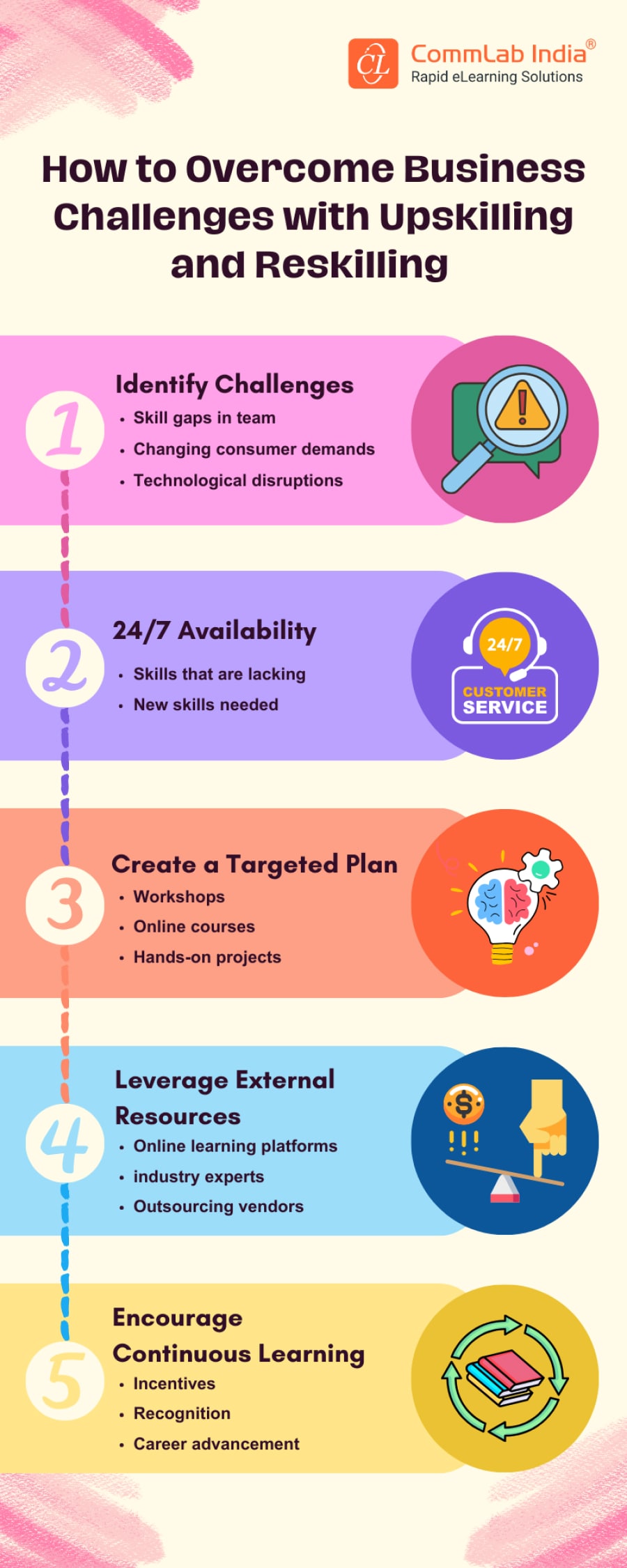How to Overcome Business Challenges with Upskilling and Reskilling [Infographic]
![How to Overcome Business Challenges with Upskilling and Reskilling [Infographic] How to Overcome Business Challenges with Upskilling and Reskilling [Infographic]](https://blog.commlabindia.com/hubfs/blogs/how-overcome-business-challenges-upskilling-reskilling-info.jpg)
The business world is a whirlwind of constant change. Technological advancements, evolving customer demands, and ever-shifting market trends all conspire to keep businesses on their toes. In this dynamic landscape, a skilled and adaptable workforce is no longer a luxury, it's a necessity. This is where upskilling and reskilling come into play. They are effective methods to overcome business challenges and propel your organization forward.
In this blog, we’ll take a detailed look at how businesses can overcome challenges with the help of upskilling and reskilling their workforce. So without any delay, let’s begin!
What is Upskilling and Reskilling?
Upskilling and reskilling are often used interchangeably, but there's a subtle difference between the two.
Upskilling focuses on building upon existing skills and knowledge, allowing employees to stay relevant within their current roles. This could involve learning new software, mastering advanced techniques, or deepening industry-specific knowledge.
Reskilling, on the other hand, equips employees with entirely new skillsets to transition into different roles within the organization. It is particularly relevant when adapting to technological disruptions or pursuing new business ventures.
→ Download Now: How L&D And Business Can Align to Conquer The Future Of Work
Need of Upskilling and Reskilling the Workforce in Business
Let's delve into how a well-designed upskilling and reskilling strategy can address various business challenges:
Bridge the Skills Gap
The pace of technological change often outpaces the development of new skills in the workforce. This creates a skills gap, hindering productivity and innovation. But with upskilling and reskilling, organizations can bridge this gap to ensure the employees possess the latest in-demand skills to excel in their current roles and utilize new technologies effectively.
Boosts Innovation and Agility
A stagnant workforce hinders an organization's ability to innovate and adapt to changing market demands. Upskilling and reskilling foster a culture of continuous learning and encourage employees to embrace new ideas and approaches. This in turn fuels innovation and allows your business to stay agile in the face of competition.
Enhances Employee Engagement and Retention
Employees who feel like they are being valued and invested in by their company are more likely to be engaged and productive. Therefore, implementing upskilling and reskilling programs is a clear way to showcase a commitment to employee development. It leads to higher job satisfaction, reduced turnover, and a more motivated workforce.
Addresses Talent Shortages
In today's competitive talent market, finding individuals with the perfect skillset can be challenging. But with the help of reskilling or even upskilling, you can equip your existing workforce with all the desired skills. This in turn proves to be a more cost-effective solution. Whether your workforce comprises Gen Z or Millenials, reskilling and upskilling enable you to tap into a readily available talent pool and reduce reliance on external recruitment.
How to Overcome Business Challenges with Upskilling and Reskilling
Parting Thoughts!
Considering the rapidly evolving business landscape, upskilling and reskilling are essential for the survival and success of any business. Investing in workforce development is the key as the future belongs to organizations with a skilled, adaptable, and future-proof workforce. So make the most reskilling and upskilling to overcome business challenges and ensure your success! To get a better hang of how L&D and business align to thrive in the competitive market, read the eBook below.






